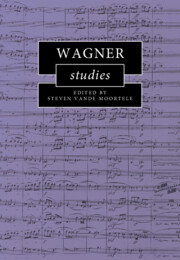Refine search
Actions for selected content:
141 results
2 - Dialogue and Play in the Nonet
-
- Book:
- Louise Farrenc: Nonet for Winds and Strings
- Published online:
- 23 October 2025
- Print publication:
- 23 October 2025, pp 58-117
-
- Chapter
- Export citation
3 - Listening Again to Haydn’s Night Watchman
-
-
- Book:
- Haydn Studies 2
- Published online:
- 18 October 2025
- Print publication:
- 16 October 2025, pp 43-69
-
- Chapter
- Export citation
2 - Understanding Haydn’s Il ritorno di Tobia through Tonkünstler-Societät Oratorio Traditions Established by Its Founder Florian Leopold Gassmann
-
-
- Book:
- Haydn Studies 2
- Published online:
- 18 October 2025
- Print publication:
- 16 October 2025, pp 15-42
-
- Chapter
- Export citation
Chapter 1 - What Exactly Is ‘Critical Thinking’?
-
- Book:
- Knowledge Doesn't Exist and Other Thoughts on Critical Thinking
- Published online:
- 22 October 2025
- Print publication:
- 21 August 2025, pp 5-22
-
- Chapter
- Export citation
Chapter 27 - Boulez the Writer
- from Part V - Multiple Activities
-
-
- Book:
- Boulez in Context
- Published online:
- 08 July 2025
- Print publication:
- 24 July 2025, pp 285-292
-
- Chapter
- Export citation
13 - Contesting Analytical Traditions
- from Part IV - Scholarship
-
-
- Book:
- The Cambridge Companion to <i>The Rite of Spring</i>
- Published online:
- 28 June 2025
- Print publication:
- 17 July 2025, pp 257-272
-
- Chapter
- Export citation
Chapter 2.12 - Statistics
- from Sec 2 - Pharmacology
-
- Book:
- Dr Podcast Scripts for the Primary FRCA
- Published online:
- 19 June 2025
- Print publication:
- 03 July 2025, pp 291-299
-
- Chapter
- Export citation
5 - Color Commentary
-
- Book:
- Gift and Grit
- Published online:
- 26 May 2025
- Print publication:
- 12 June 2025, pp 152-181
-
- Chapter
- Export citation
The language of non-journalistic true crime podcasts: A preliminary analysis of the pragmatic markers in True Crime Obsessed
-
- Journal:
- English Today / Volume 41 / Issue 2 / June 2025
- Published online by Cambridge University Press:
- 30 May 2025, pp. 110-120
- Print publication:
- June 2025
-
- Article
-
- You have access
- Open access
- HTML
- Export citation
5 - Scena, Form and Drama in Act 1 of Die Walküre
- from Part II - Form, Drama and Convention
-
-
- Book:
- Wagner Studies
- Published online:
- 17 April 2025
- Print publication:
- 24 April 2025, pp 93-112
-
- Chapter
- Export citation

Wagner Studies
-
- Published online:
- 17 April 2025
- Print publication:
- 24 April 2025
Chapter 6 - Principles and Guidelines for Teaching History
-
- Book:
- Teaching History in Higher Education
- Published online:
- 07 February 2025
- Print publication:
- 20 February 2025, pp 215-250
-
- Chapter
- Export citation
Conversation 2 - Dispute Resolution Transformed by Technology
-
- Book:
- Legal Innovation
- Published online:
- 06 February 2025
- Print publication:
- 13 February 2025, pp 32-63
-
- Chapter
-
- You have access
- Open access
- HTML
- Export citation
Chapter 3 - What Are the Perspectives and Levels of an Analysis?
-
- Book:
- Introducing Practical Discourse Analysis
- Published online:
- 20 December 2024
- Print publication:
- 09 January 2025, pp 67-96
-
- Chapter
- Export citation
Chapter 7 - A Model for Doing Discourse Analysis
-
- Book:
- Introducing Practical Discourse Analysis
- Published online:
- 20 December 2024
- Print publication:
- 09 January 2025, pp 179-204
-
- Chapter
- Export citation
Introduction
-
- Book:
- The Hamas Intelligence War against Israel
- Published online:
- 21 November 2024
- Print publication:
- 28 November 2024, pp 5-13
-
- Chapter
- Export citation
Discussion and Conclusions
-
- Book:
- The Hamas Intelligence War against Israel
- Published online:
- 21 November 2024
- Print publication:
- 28 November 2024, pp 177-184
-
- Chapter
- Export citation
Race, ethnicity, and considerations for data collection and analysis in research studies
-
- Journal:
- Journal of Clinical and Translational Science / Volume 8 / Issue 1 / 2024
- Published online by Cambridge University Press:
- 29 October 2024, e182
-
- Article
-
- You have access
- Open access
- HTML
- Export citation
10 - Decision Inputs
- from Part III - The Pollster as Fortune Teller
-
- Book:
- Polls, Pollsters, and Public Opinion
- Published online:
- 01 November 2024
- Print publication:
- 04 July 2024, pp 147-166
-
- Chapter
- Export citation
4 - HLVC Methods and Tools
-
- Book:
- Heritage Languages
- Published online:
- 09 July 2024
- Print publication:
- 27 June 2024, pp 37-91
-
- Chapter
- Export citation
